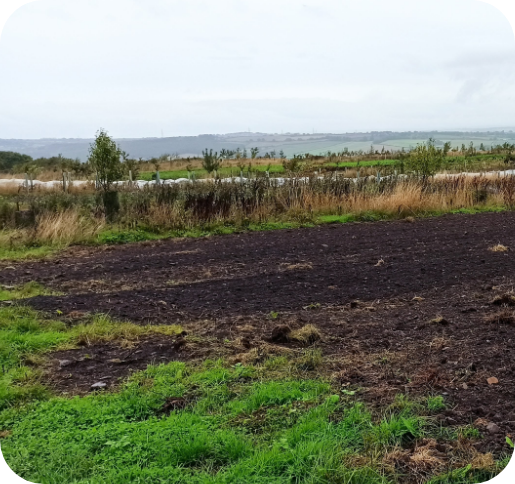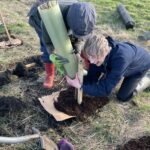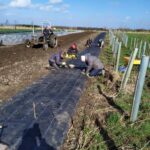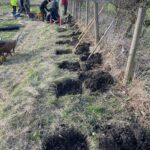

Kapcsolattartó személy:
Rachel Putz
Igazgató

Olvassa el az Élő Laboratóriumról szóló híradást itt
Olvassa el a "Az agrárerdészet talajegészségre gyakorolt hatásainak számszerűsítése a Gibside közösségi gazdaságban" című frissített kutatást. itt
Nézzen meg egy videót a Living Labról az Egyesült Királyságban
LIVING LAB 7: Egyesült Királyság
Gibside közösségi gazdaság
Közösség által támogatott mezőgazdasági (CSA) gazdaság
Általános információ
A Gibside CSA 30 percre található Gateshead/ Newcastle upon Tyne-tól, Észak-Angliában. A gazdaság egy tagok által létrehozott közösségi érdekeltségű társaság (CIC), két igazgatóval és egy további három főből álló irányítócsoporttal. Körülbelül 20 tag van, akik nyáron heti 13 órában rendszeresen járnak a földekre, hogy a szerződéses termelők támogatásával termeljenek. A Gibside Community Farm (GCF) egy 5,8 hektáros (ha) szántóföldet bérel a National Trust. A tagok közül sokan rendelkeznek tapasztalatokkal a kisparcellás termesztésben, de ez egy támogató hely is, ahová az emberek eljönnek, hogy megismerkedjenek a biotermesztéssel.
A National Trust nagyon támogatta a birtokukon kialakítandó közösségi gazdaság ötletét, és segített az alapító tagoknak a CIC 2013-as létrehozásában. 2017-ben a földterületet bérbe adták, és megkezdődhetett az infrastruktúra elhelyezése a helyszínen. A Gibside National Trust birtokkal 25 évre szóló mezőgazdasági vállalkozási bérleti szerződést kötöttek, és a hosszú bérleti idő lehetővé tette, hogy a CSA támogatást kapjon a fák megvásárlásához. Az agrárerdészet kezdettől fogva része volt a Gibside Community Farm tervezésének. Az első támogatást aMOREwoods' kezdeményezését a Woodland Trust. Azonban csak őshonos fákat tudtak szállítani, és a fajtaválaszték korlátozott volt. Egy helyi jótékonysági alapítvány megkeresése után további 3000 fontot sikerült biztosítani a GCF szilváskertészeti rendszeréhez illő fák beszerzéséhez. A Agroforestry Research TrustMartin Crawford adott tanácsot.
A fák beépítésének egyik fő oka az volt, hogy csökkentsék a szél hatását ezen a nagyon kitett helyen. A fáknak a zöldségtermesztésre gyakorolt további előnyei és más előnyös kapcsolatok is szempontok voltak.
Az erdei növénytermesztési terület kezdeti létrehozásakor a GCF tagjai a rendszerre tekintettek a Wakelyns és Tolhurst Organic azzal a céllal, hogy potenciálisan megismételjék az általuk végzett munka elemeit. Figyelembe vették Ian Tolhurst tanácsát is a gazdaság tervének megvalósíthatóságával kapcsolatban. A fasorokban lévő fák többsége még éretlen, 5 éves. A védősávok fiatal, 7-8 éves őshonos fákból állnak, mint például dió, szelídgesztenye, éger, nyír, tölgy és erdeifenyő.
Kezdetben a CSA a National Trust falakkal körülvett kertjében működött, hogy tesztelje a modellt, mielőtt átköltözött volna a jelenleg használt, nagyobb területre. Mielőtt az 5,8 hektáros területet átállították a selyemkertészetre, az egy szántóföldi vetésforgó része volt.
A zöldségtermesztést főként zacskós rendszerben értékesítik a tagoknak. Ez a termék tartalmazza mindazt, aminek éppen szezonja van a gazdaságban, és egy online rendszeren keresztül is értékesítik. Az értékesítés egyéb módjai a biogazdálkodással foglalkozó nagykereskedés, a National Trust Gibside piacterén felbukkanó stand és alkalmi piacok. A 2023-as termésmennyiség 10,45 tonna volt, amely 5,5 tonna burgonyát, 1,6 tonna hagymát, 223 kg céklát, 2,22 tonna káposztaféléket és 294 kg hüvelyeseket tartalmazott.
Általános gazdálkodási megközelítés
Szerves
Célok
Mivel a Gibside egy CSA-farm, a fő cél az, hogy a zsákos rendszer révén környezetbarát módon, organikus, szezonális és helyi zöldségeket termeljen tagjai számára. Az önkéntesek bevonása lehetővé teszi a helyi lakosság közvetlen részvételét a CSA-ban, miközben gazdaságilag is életképessé teszi a projektet.
- A selyemkertészeti agrár-erdészeti rendszer segít a zöldségágyásoknak védelmet nyújtani, mivel a terület magasan fekszik és kitett, így gyakran sok szél fúj. A gazdaság kerületét nagyobb védőövezetek is védik, amelyek több sor félérett őshonos fát tartalmaznak. A fasorok mikroklímát teremtenek, ami kedvez a zöldségtermesztésnek. A gazdaságban lévő fák révén potenciálisan egy további bevételi forrás is létrejöhet.
- A CSA támogatta a helyi közösséget a Waste Food Kitchen (Hulladék Élelmiszerkonyha) számára történő gyűjtéssel (zöldség- és gyümölcsfelesleg) (Magic Hat Cafe).
Kihívások
- A fák beszerzése a Woodland Truston keresztül kezdetben kihívást jelentett, mivel a rendelkezésre álló fajták csak őshonos fajokra korlátozódtak, és olyanokra, amelyek nem voltak alkalmasak az agrár-erdészeti rendszerhez. A Gibside Community Farm egy helyi jótékonysági alapítványhoz fordult, amely támogatást nyújtott ahhoz, hogy egy agroerdészeti szakembertől szerezzen fákat.
- Kihívást jelentett a forgatás helyszíni illesztése a mások által végzett munkák alapján, valamint a legjobb sikátorszélesség és -hossz meghatározása - a helyszíni méretarányhoz jó munkahosszra volt szükség.
- A fő probléma, amellyel a gazdaságban próbálnak megbirkózni, az, hogy miként lehet minimalizálni a talajművelést a zöldségekben. Remélik, hogy találnak egy olyan megközelítést, amely nem igényel drága eszközöket, és a kézi művelés nem kivitelezhető az időigény miatt. Jelenleg a gyomok csapkodására hagyatkoznak.
- Folyamatos kihívást jelent elegendő zöldségtáskás vásárlót találni ahhoz, hogy a belőlük származó pénz a fő bevételi forrássá váljon. Szeretnék megtalálni az egyensúlyt a biogazdálkodási nagykereskedelembe és a közvetlen értékesítésbe kerülő termények mennyisége között.
- A múltban F1 vetőmagokat használtak, ami korlátozó volt, mivel ezek mindent egyszerre termelnek, és ez nem illik a heti zöldségtáskás modellhez. A jövőben nyílt beporzású vetőmagokat szeretnének használni a GCF-ben, hogy a termények a vegetációs időszak során folyamatosan rendelkezésre álljanak, és szakaszosan lehessen szedni őket.
Kutatási célok
A remény az, hogy több fát integrálnak a gazdaságba, mivel a gazdaság egyik oldalán még mindig szélprobléma van, és mivel néhány sor agroerdészet nem vált be, és ezeket ki kell cserélni. A GCF érdeklődik a további fafajok iránt, amelyeket a tartaléksávokba lehetne ültetni.
A CSA gazdaságossága is számít, mivel a CSA nem tudna tovább működni, ha nem lenne pénzügyileg életképes. Az agrárerdészet potenciálisan további bevételi forrást teremt a gazdaság számára, és olyan mikroklímát hoz létre, amely lehetővé teszi a zöldségek növekedését.
A telephelyet üzemeltető csapat reméli, hogy a REFOREST Élő Laboratórium foglalkozni fog a talajművelés csökkentésének kérdésével egy ilyen szerves rendszerben, és az ebből eredő gyomok kezelésével. Jelenleg nincs olyan megoldásuk, amely nem túl drága vagy időigényes, de szívesen fogadnák az élő laboratóriumban részt vevő többi gazdálkodó hozzájárulását ehhez.
Az agrár-erdészeti rendszer kialakítása
Az 5,8 hektáros selyemkertészeti területen 7 zöldségültetvény található, amelyek között 3 méter széles fasorok húzódnak. Minden ágyás 21 m x 100 m. A parcellák 7 ciklusos vetésforgót követnek: burgonya, káposztafélék és hagymák, majd 4 éves vetésforgó következik hosszú távú zöldtrágyázással. A parcellákat célzottan szélesre tervezték, hogy a fák és a zöldségek közötti versenyt a lehető legkisebbre csökkentsék, valamint lehetővé tegyék a szántóföldi gépek használatát. A fasorok fái között kosárfűz, mogyoró, törékeny gyümölcsű és kemény gyümölcsű fák találhatók. A szántóföldnek azt az oldalát, ahol nincsenek fasorok, gabonafélék és hüvelyesek termesztésére használták, de jelenleg szénaföldként használják. A parcellák között sövényekkel szegélyezett veteményeskert is található.
Az egész gazdaságot védő nagyobb védőövezetek több sor félérett őshonos fát tartalmaznak, és jelentős szélvédelmet nyújtanak. A védőövezetek a termőterület délnyugati, nyugati és északnyugati részén húzódnak. A gazdaság bejáratánál egy északkeleti szélvédő is található. A selyemkertészeti ágyásoktól északra, a szántóföld északnyugati részén található egy gyümölcsös terület, amelyet egy északi sövény némi védelemmel lát el. Jelenleg 44 almafából áll, főként MM106-os alanyra ültetett félstandard almafákból. A gyümölcsösben termő vegyes gyümölcsfafajták nagyra értékeltek, mivel a gyümölcsök szüretelésének ideje eltolódik, ami biztosítja, hogy a gyümölcs hosszabb ideig álljon rendelkezésre.
A gazdaság egy helyi istállóból származó lótrágyát használ a zöldségágyásokhoz. Van egy nagyméretű polytunnel, amelyet öntözőberendezéssel öntöznek. A nagy szénaterületet egy vállalkozó vágja le, évente mintegy 33 silózásra.
A weboldal figyelemmel kísérése
A gazdaságban már korábban is gyűjtöttek szabványos talajadatokat, és a közelmúltban a REFOREST projekt részeként kiterjedt talaj- és termőképességi adatokat gyűjtöttek. Ezt a jövőben újra el lehetne végezni, hogy megnézzük, javult-e a talaj állapota az agrár-erdészeti rendszerrel.
A helyszínen van egy esőmérő, de jelenleg nincs időjárásmérő állomás.
Kulcskérdés, hogy miként lehet a zöldségültetvények talajművelését drága berendezések használata nélkül minimalizálni. Ha megtudjuk, hogy az emberek milyen módon teszik ezt, akkor különösen érdemes lenne részt venni a UK Living Lab programban.
 Betöltés...
Betöltés...

Anglia, Egyesült Királyság

Fellside Rd, Burnopfield, Newcastle upon Tyne, NE16 5LA

Selyemkertészet, gyümölcsösök, sövények, védősávok és parti pufferzónák

Számos zöldségféle, beleértve az alliumokat, káposztaféléket és burgonyát is

A mezőt a National Trust bérli, és a hivatalos bérleti szerződést 2017-ben kötötték meg. A faültetés 2016 telén kezdődött a gyümölcsösön, 2017 telén pedig a fasorokon és a védősávokon.

Sorok közötti/sorok közötti távolság: 21 m x 100 m

A facsíkok szélessége: 3m sikátorok - védőövezet 5m

5,8 ha megművelt terület
1,47 ha zöldségfélék
0,2 ha fasorok

Kertészet

Állattenyésztés: Nem







